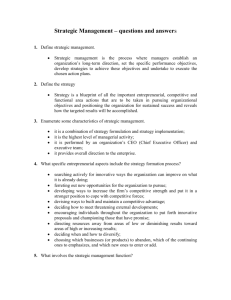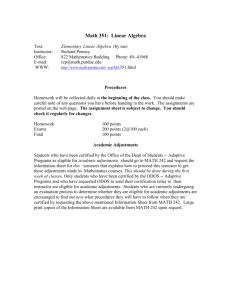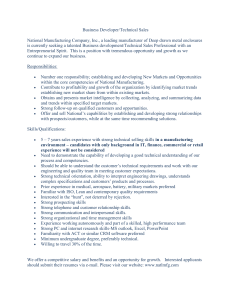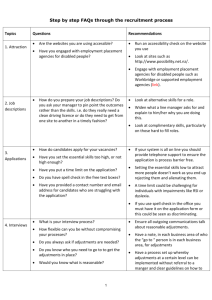Short Essay on Strategic Management
advertisement
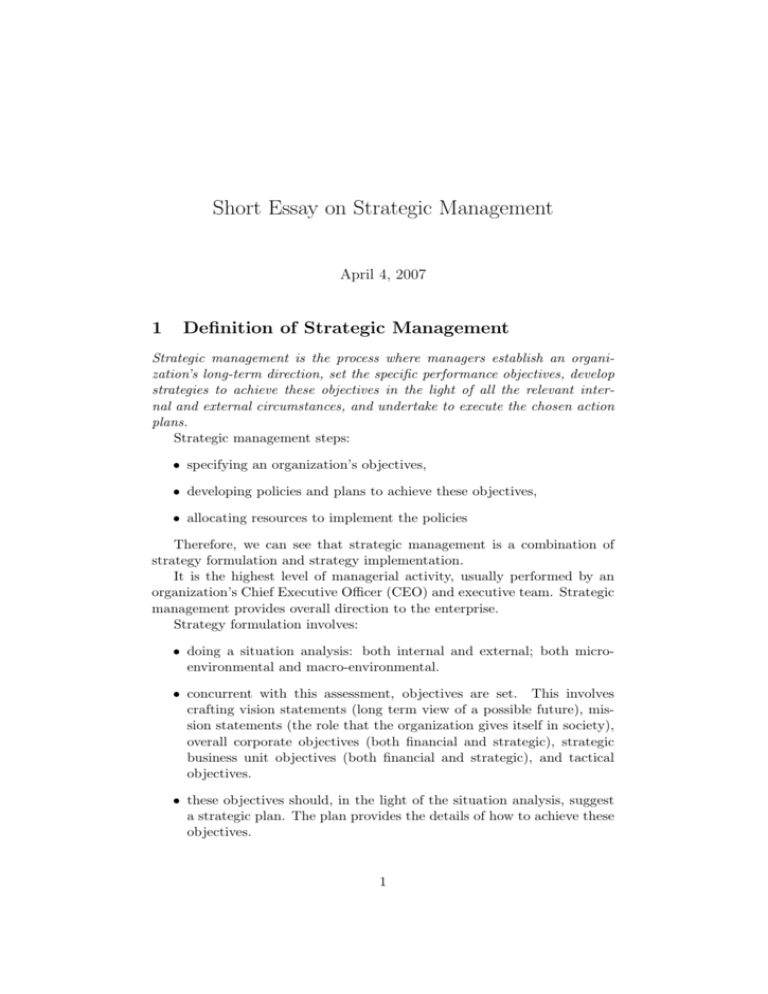
Short Essay on Strategic Management April 4, 2007 1 Definition of Strategic Management Strategic management is the process where managers establish an organization’s long-term direction, set the specific performance objectives, develop strategies to achieve these objectives in the light of all the relevant internal and external circumstances, and undertake to execute the chosen action plans. Strategic management steps: • specifying an organization’s objectives, • developing policies and plans to achieve these objectives, • allocating resources to implement the policies Therefore, we can see that strategic management is a combination of strategy formulation and strategy implementation. It is the highest level of managerial activity, usually performed by an organization’s Chief Executive Officer (CEO) and executive team. Strategic management provides overall direction to the enterprise. Strategy formulation involves: • doing a situation analysis: both internal and external; both microenvironmental and macro-environmental. • concurrent with this assessment, objectives are set. This involves crafting vision statements (long term view of a possible future), mission statements (the role that the organization gives itself in society), overall corporate objectives (both financial and strategic), strategic business unit objectives (both financial and strategic), and tactical objectives. • these objectives should, in the light of the situation analysis, suggest a strategic plan. The plan provides the details of how to achieve these objectives. 1 This three-step strategy formulation process is sometimes referred to as : 1. determining where you are now, 2. determining where you want to go, and then 3. determining how to get there. These three questions are the essence of strategic planning. Strategy implementation involves: • allocation of sufficient resources (financial, personnel, time, technology support) • establishing a chain of command or some alternative structure (such as cross functional teams) • assigning responsibility of specific tasks or processes to specific individuals or groups • it also involves managing the process. This includes monitoring results, comparing to benchmarks and best practices, evaluating the efficacy and efficiency of the process, controlling for variances, and making adjustments to the process as necessary. • when implementing specific programs, this involves acquiring the requisite resources, developing the process, training, process testing, documentation, and integration with (and/or conversion from) legacy processes. 2 The Components of Strategic Management • defining the organization’s business and developing a strategic mission • establishing strategic objectives and performance targets • formulating a strategy to achieve the objectives • implementing an executing the chosen strategic plan • evaluating strategic performance and making corrective adjustments 2 2.1 Defining the Business “What is our business and what will it be?” is the fundamental directionsetting question facing the senior managers of any enterprise. Addressing this question thoughtfully compels executives : • to think through the scope and mix of organizational activities, • to reflect on what kind of organization they are presently trying to create, • to consider what markets they believe the organization should be in, and • to be specific about which needs of which buyers to serve The management’s view of what the organization seeks to do and to become over the long-term is the organization’s strategic mission. 2.2 Establishing Strategic Objectives Specific performance targets are needed in all areas affecting the survival and success of an enterprise and at all levels of management from the corporate level on down deep into the organization’s structure. The act of establishing formal objectives not only converts the direction an organization is headed into specific performance targets to be achieved but also guards against drift, aimless activity, confusion over what to accomplish, and loss of purpose. What is establishing formal objectives? • conversion of the target direction into specific performance targets to be achieved • guard against – drift, – aimless activity, – confusion over what to accomplish, and – loss of purpose Both short-run and long-run objectives are necessary. The strategic objectives for the organization should at minimum specify: • the market position and competitive standing the organization aims to achieve • annual profitability targets 3 • key financial and operating results to be achieved through the chosen activities • any other milestones by which strategic success will be measured 2.3 Formulating Strategy This component of strategic management reveals how the targeted results will be accomplished (a detailed action plan is necessary to achieve both short-run and long-run results). Objectives are the “ends” and strategy is the “means” of achieving them. Strategy is a blueprint of all the important entrepreneurial, competitive and functional area actions that are to be taken in pursuing organizational objectives and positioning the organization for sustained success. General Electric opinion on the issue is: “a statement of how what resources are going to be used to take advantage of which opportunities to minimize which threats to produce a desired result”: How to respond to changing conditions • what to do about shifting customer needs and emerging industry trends • which new opportunities to pursue • how to defend against competitive pressures and other externally imposed threats • how to strengthen the mix of the firm’s activities by doing more of some things and less of others How to allocate resources • over the organization’s various business units, divisions, and functional departments • making decisions that steer capital investment and human resources in behind the chosen strategic plan How to compete • how to develop customer appeal • how to position the firm against rivals • to emphasize some products and de-emphasize others • meet specific competitive threats What actions and approaches to take in each of the major functional areas and operating departments to create a unified and more powerful strategic effort throughout the business unit. 4 The issue of strategy goes up and down the managerial hierarchy (it is not just something that only top management wrestles with). Strategy formation is largely an exercise in entrepreneurship reflecting the long-term direction of the organization. Analysis (situational analysis) and judgement are always factors. The right choice and strategy for one organization need not be right for another organization. One of the special values and contributions of managers is an ability to develop customized solutions that fit the unique features of an organization’s situation. 2.4 Strategy Implementation and Execution Putting the strategy into place and getting individuals and organizationals subunits to go all out in executing their tasks is the next step. The leadership challenge is to so stimulate the enthusiasm, pride and commitment of managers and employees that an organization wide crusade emerges to carry out the chosen strategy and to achieve the targeted results. 2.5 Evaluating Strategic Performance and Making Corrective Adjustments Neither strategy formulation nor strategy implementation is a once-forall-time task. Corrective adjustments may be necessary under particular circumstances. Testing out new ideas and learning what works and what doesn’t through trial and error is common. Thus, it is always incumbent upon management to monitor both how well the chosen strategy is working and how well implementation is proceeding, making corrective adjustments whenever better ways of doing things cand be supported. 2.6 The Process of Strategic Management Because each component of strategic management entails judging whether to continue with things as they are or to make changes, the task of managing strategy is a dynamic process - all strategic decisions are subject to future modifications. 2.6.1 Characteristics of the Process • managers do not necessarily go through the sequence in rigorous lockstep fashion. • the tasks involved in strategic management are never isolated from everything else that falls within a manager’s purview • the demands that strategy management puts on the manager’s time are irregular 5 • formulating and implementing strategy must be regarded as something that is ongoing and that evolves The strategy implementation is the product of incremental improvements, internal fine-tuning, the pooling effect of many administrative decisions and gradual adjustments in the actions and behavior of both managerial subordinates and employees. 3 Who Are the Strategy Managers It goes without saying that an organization’s CEO (chief executive officer) and COO (chief operating officer) are strategy managers with ultimate authority and responsibility for formulating and implementing the strategic plans of the organization as a whole. But... those who implement the plan must make the plan! The strategic management function directly involves all managers with line authority at the corporate, line-of-business, functional area and major operating department levels. 4 Why Strategic Management Matters The advantages of first-rate strategic thinking and a deep commitment to the strategic management process include: 1. the guidance it provides to the entire management hierarchy in making clear just “what it is we are trying to do and to achieve” 2. the contribution it makes to recognizing and responding to the winds of change, new opportunities, and threatening developments 3. the rationale it provides for management in evaluating competing requests for investment capital and new staff 4. the coordination it adds to all the strategy-related decision making done by managers across the organization 5. the proactive instead of the reactive posture that it gives to the organization 6
